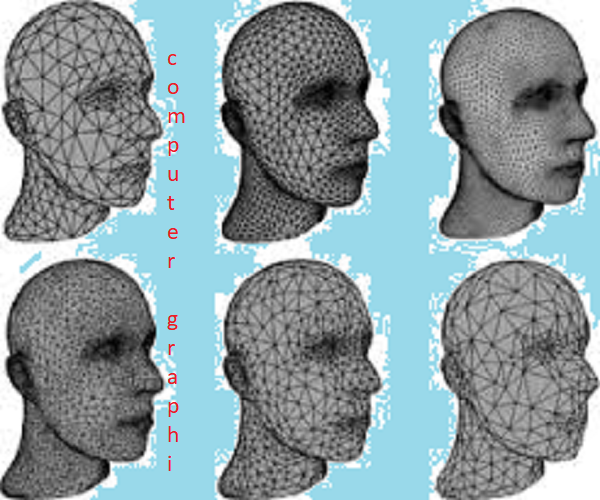Definition of computer graphics-: Graphics is the main part of multimedia. Graphics include still Pictures, image and Photo alone and those with dynamic movements like animation.
To display a image of any size on a computer screen is a difficult process. Computer graphics are used to simplify this process. Various algorithms and techniques are used to generate graphics in computers.

The computer graphics is concern with generation, representation, manipulation and display of pictures with the aid of computer. It may be divided into three broad area
- generative graphics.
- cognitive graphics
- Image processing.
Application of computer graphics-: Computer graphics use in many application as like
- Computer graphics user interfaces (GUI) − A computer graphic, mouse-oriented paradigm which allows the user to interact with a computer.
- Business presentation graphics − A picture is worth a thousand words..
- Cartography − computer graphics is use making a drawing.
- Photo Enhancement − In Sharpening blurred photos computer graphics is used.
- Weather Maps − in the real-time mapping, symbolic representations computer graphics is use
- Satellite Imaging −For creating Geodesic images it is used.
- Medical imaging − In the hospital laboratory in MRI, CT scans etc. – Non-invasive internal examination computer graphic is used.
- Typography − The use of character images in publishing – replacing the hard type of the past.
- Engineering drawings − mechanical, electrical, civil, etc. are replace by the blueprints of the past.
- Art − Computers provide a new medium for artists. where we can make best design in computer.
- Training − Flight simulators, computer aided instruction, etc.
- Entertainment − For creating Movies and games we give good effects by the help of computer graphics.
There are many application are of computer graphics
Computational Biology: It is an interdisciplinary field that applies the techniques of computer science, applied mathematics and statistics to address biological problems. The main focus lies on developing mathematical modelling and computational simulation techniques.
Computational Physics: Computational physics is the study and implementation of numerical algorithm to solve problems in physics for which a quantitative theory already exists. It is often regarded as a sub discipline of theoretical physics but some consider it an intermediate branch between theoretical and experimental physics.
Information of Graphics: information graphics are visual representations of information, data or knowledge. These graphics are used where complex information needs to be explained quickly and clearly such as in maps,signs, technical,writing,education journalism etc.. They are also used extensively as tools by computer scientists, mathematicians, and statisticians to ease the process of developing and communicating conceptual information.
Scientific Visualisation: This is the branch of science concerned with the visualisation of three dimensional phenomena, such as architectural, meteorological, medical, biological systems. Scientific visualisation focuses on the use of computer graphics to create visual images which aid in understanding of complex, often massive numerical representation of scientific concepts or results.
Graphic Design: The term graphic design can refer to a number of artistic and professional disciplines which focus on visual communication and presentation.Many methods are used to create and combine symbols, images or words to create a visual representation of ideas and messages.
Computer-aided Design: Computer-aided design (CAD) is the use of computer technology for the design of objects, real or virtual. The design of geometric models for object shapes, in particular, is often called computer-aided geometric design . CAD may be used to design curves and figures in two-dimensional space; or curves, surfaces, or solids in three-dimensional objects. CAD is also widely used to produce computer animation for special effects in movies, advertising, technical manuals.
Web Design: Web design is the part of designing presentations of content usually hypertext or hypermedia that is delivered to an end-user through the World Wide Web, by way of a Web browser.In the web designing it is very important.
Video Games: A video game is an electronic game that involves interaction with a user interface to generate visual feedback on a raster display device. The electronic systems used to play video games are known as platforms. This platform creates through graphics.
Virtual Reality: Virtual reality (VR) is a technology which allows a user to interact with a computer-simulated environment. The simulated environment can be similar to the real world.
Computer Simulation: A computer simulation, a computer model or a computational model is a computer program, or network of computers, that attempts to simulate an abstract model of a particular system.
Education: . Computer simulations have become a useful part of mathematical modelling of many natural systems in physics (computational physics), chemistry and biology, human systems in economics, psychology, and social science and in the process of engineering new technology, to gain insight into the operation of those systems, or to observe their behaviour.
Digital Art: Digital art most commonly refers to art created on a computer in digital form. In other words we can say that it is a term applied to contemporary art that uses the methods of mass production or digital media. The impact of digital technology has transformed traditional activities such as drawing,painting,and sculpture while new forms, such as net art, digital installation art, and virtual reality have been recognized artistic practices.
Information Visualisation: Information visualisation is the study of the visual representation of large-scale collections of non-numerical information, such as files and lines of code in software systems, and the use of graphical techniques to help people understand and analyse data.